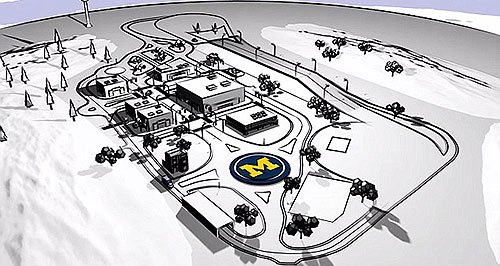Make / Model Search
News - General News - TechnologyUS trial to test how ITS and automation combineOn top of things: An aerial view of the University of Michigan’s ‘M City’ 32-acre autonomous vehicle test facility under construction. Autonomous transportation system could be operating in Michigan early next decade15 May 2015 By IAN PORTER THE University of Michigan Transport Research Institute (UMTRI) is about to begin the world’s first real-world research program into how ITS technology and automated vehicles can work together, using a purpose-built road network in Ann Arbor, 80km south of Detroit. Under the guidance of Australian-born director Peter Sweatman, the UMTRI is already running the world’s largest trial of intelligent transport system (ITS) technology on the roads in Michigan, with the fleet of 4000 vehicles expected to rise to 9000 over three years. Delivering a speech to the ITS Summit in Melbourne this week, Dr Sweatman said the new trial into how ITS and automated vehicle technology will work together will be conducted on a dedicated site, known as M City, which is nearly complete. The M City trial has been designed with a view to using the results to establish an automated mobility system on the streets of Ann Arbor within approximately eight years, Dr Sweatman said. The $US8 million ($A9.9 million) M City network will emulate city streets, much like an outdoor movie set, with building facades providing blind corners and all the other hazards that drivers face every day. Trials are due to start in July, with Dr Sweatman explaining that a key goal will be studying the customer experience of the automated system, which in this case will involve vehicles that can be “called up” from a smartphone. “We want to figure out how that would work, what people like about it, what they don’t like about it, because that is the kind of system we will need on a big scale,” he said. “We don’t really understand what people want from automation that’s part of what we are trying to do.” Dr Sweatman said automated vehicles of the future would not simply be versions of current cars, and may not even carry people in many instances. He said only the basic outline of the envisaged automated mobility system for Ann Arbor had been laid down. “The key characteristics are that it will be automated, or driverless, and shared,” he said. “The vehicle comes to you, you go somewhere, the vehicle (then) goes away and does something else.” Dr Sweatman pointed to work underway in Europe on an automated shuttle, which he said was a very unconventional-looking vehicle. “I think there will be a lot of unconventional automated vehicles springing up. The current paradigm of the automobile to which you apply automation is only going to be part of it,” he said. He added that the freight transport industry was likely to be an early adopter of the technology given the potential to alleviate traffic flow problems during deliveries. “The implications for freight, the so-called last-mile freight delivery in urban areas, are pretty significant,” he said. “The same kinds of machines and technologies can be used for people and freight. That’s an exciting possibility. “There is a quite a bit of work being done on ‘platooning’ of trucks on freeways and also this ‘traffic jam assist’, where the driver can relax when the car is crawling along in traffic. “Some companies say their aim is to take the boring part out of driving, the parts that people don’t like doing, and provide products that are going to cover those situations.” However, he cautioned that automated vehicles are going to be noticeably more expensive than conventional models for some time, despite the fact that ITS connectivity was affordable. “Vehicle to vehicle (V2V) and vehicle to infrastructure (V2I) connectivity is highly affordable and was always intended to be,” Dr Sweatman said. “(But) when it comes to automation in vehicles, certainly there is a high cost now.” He said the cost of the radar-like sensor in a driverless car, such as the one Google is using in its autonomous vehicle program, was particularly prohibitive. “Automated cars have to have a 360-degree (view), a very accurate map of everything around the vehicle, including the ability to recognise landmarks to the rear,” he said. “You need to know where you are on the map. “One way to look at it is that the ITS technology is just another sensor, one of the more powerful sensors and also one of the more affordable sensors. “But for a driverless vehicle, you still need a lot of other sensors on the vehicle.”  Read more11th of May 2015  Stage almost set for communicating carsMinor legal changes needed for car-to-car tech and driverless vehicles in Oz5th of May 2014  Technology promises transport upheavalSmart roads, autonomous cars, tech-savvy passengers will change personal mobility19th of September 2013  Fight to save V2X radio for road safety‘Huge’ road safety breakthrough threat as US considers radio spectrum auction |
Click to shareGeneral News articlesResearch General News Motor industry news |











Facebook Twitter Instagram